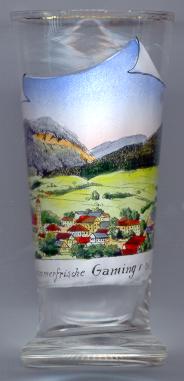

|
| ÖSTERREICH | AUSTRIA |
| Bundesland: Niederösterreich | Lower Austria |
| Bezirk: Scheibbs |
 Gaming is situated at an elevation of 430 m in the Ötscher mountains in southwest Lower Austria.
The municipality has a population of about 3280 (2011) and is divided into the cadastral districts of
Altenreith, Brettl, Gaming, Kienberg, Lackenhof, Mitterau, Nestelberg, Neuhaus, Polzberg.
Gaming is situated at an elevation of 430 m in the Ötscher mountains in southwest Lower Austria.
The municipality has a population of about 3280 (2011) and is divided into the cadastral districts of
Altenreith, Brettl, Gaming, Kienberg, Lackenhof, Mitterau, Nestelberg, Neuhaus, Polzberg.
The first written mention of Gemnik dates from 1274.
In 1322, the Habsburg Dukes Albrecht II (1298–1358) and his brother Leopold I (1290–1326) vowed to
build a monastery. After the death of Leopold, Albrecht started to build the Carthusian monastery of Gaming in 1332. Ten
years later, the monastery church was completed.
Scheibbs became the seat of the administration of the monastery's domains in 1338. In 1782 the
monastery was closed by order of Emperor Joseph II. At that time the monastery had more than 500 monks. The possessions
of the monastery were sent to Vienna. However, the largest part including precious manuscripts from
the monastery library never arrived there and are still missing today. In 1898, the last part of the narrow gauge railway
line in the Ybbs valley from Kienberg/Gaming to
The  parish church Sankt Philipp und Jakob [far left, barely visible] was
completed in 1520 in late Gothic style. The Baroque high altar originally stood in the funeral chapel of the Carthusian
monastery. Between 1797 and 1985, the remains of Albrecht II were buried next to the altar. The Baroque organ, which
originally stood in a former monastery in Ybbs an der Donau, is said to have been played by
Wolfgang Amadeus Mozart in 1762. The church tower dates from prior to 1844. The stone relief above the south entrance of
the church ("Gaminger Vesperbild") dates from 1420. Between Christmas and Candlemas (Purification of the Virgin Mary or
Presentation of Christ in the Temple, 2 February) the Baroque nativity scene of around 1720 with its 1-metre-tall wooden
figures is exhibited in the church.
parish church Sankt Philipp und Jakob [far left, barely visible] was
completed in 1520 in late Gothic style. The Baroque high altar originally stood in the funeral chapel of the Carthusian
monastery. Between 1797 and 1985, the remains of Albrecht II were buried next to the altar. The Baroque organ, which
originally stood in a former monastery in Ybbs an der Donau, is said to have been played by
Wolfgang Amadeus Mozart in 1762. The church tower dates from prior to 1844. The stone relief above the south entrance of
the church ("Gaminger Vesperbild") dates from 1420. Between Christmas and Candlemas (Purification of the Virgin Mary or
Presentation of Christ in the Temple, 2 February) the Baroque nativity scene of around 1720 with its 1-metre-tall wooden
figures is exhibited in the church.
![[scale]](lineal.jpg)